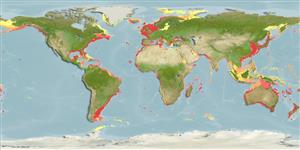Common names from other countries
Environment: milieu / climate zone / depth range / distribution range
Ecologie
Pelagisch; brakwater; diepteverspreiding 0 - 200 m (Ref. 1134). Tropical; 3°C - 30°C (Ref. 1134)
Circumglobal except Antarctic.
Length at first maturity / Size / Gewicht / Leeftijd
Maturity: Lm ? range ? - ? cm Max length : 0.2 cm TL mannelijk/geslacht niet bekend; (Ref. 1610)
Marine, planktonic; found at depths up to 200 m, with waters temperatures of 3.2 to 29.5°C; rare in the open sea (Ref. 1134). Prefers neritic ambience (Ref. 3531). Found in mangrove vegetate area (Ref. 121475).
Life cycle and mating behavior
Geslachtsrijpheid | Voortplanting | Kuitschieten | Eieren | Fecundity | Larven
Members of the class Appendicularia are protandrous hermaphrodites. Life cycle: Eggs develop into hatchlings (feeding juveniles) before turning into adults.
Hopcroft, R.R., J.C. Roff and H.A. Bouman. 1998. (Ref. 378)
Status op de Rode Lijst van het IUCN (Ref. 130435)
Status bij CITES (Ref. 108899)
Not Evaluated
Not Evaluated
Gebruik door de mens
| FishSource |
Tools
Meer informatie
Leeftijd/GrootteGroeiLengte-gewicht parametersLengte-lengte parametersMorfologieLarvenAbundantie
Internet-bronnen
Estimates based on models
Preferred temperature
(Ref.
115969): 6.5 - 25.9, mean 13.6 (based on 2008 cells).
Kwetsbaarheid
Low vulnerability (10 of 100).
Prijsklasse
Unknown.
